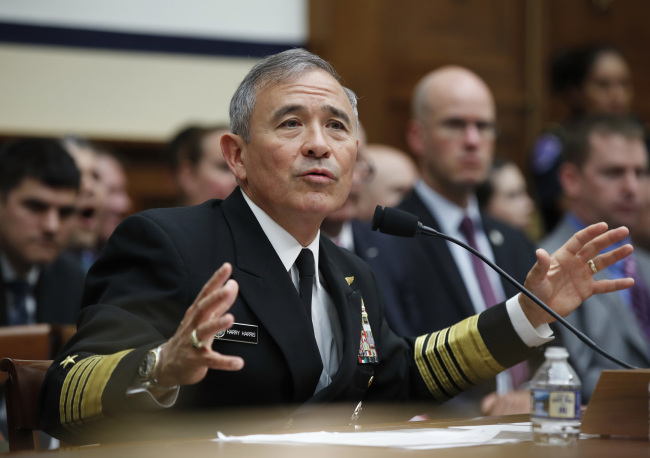A top US commander was found Wednesday to have said the country is working to create a “fully-integrated” regional missile defense scheme that includes South Korea, fueling controversy over the deployment of a US missile shield that US President Donald Trump wants Seoul to pay $1 billion for.
Controversy has persisted over the deployment of a Terminal High Altitude Area Defense battery here, which China argues constitutes Seoul’s de facto participation in the US-led global missile defense program. South Korea has dismissed the view, as it has been developing its own missile defense system such as the Korea Air and Missile Defense pre-emptive strike scheme, which it said will be interoperable with -- but not part of -- the US’ systems.
In his testimony to the US House Committee on Armed Service last Wednesday, however, US Pacific Command Commander Adm. Harry Harris said otherwise, signaling the ongoing THAAD stationing might be a part of US efforts to build a regional missile defense scheme.
“USPACOM will continue working with Japan, the ROK, and Australia to improve our level of staff coordination and information sharing and the goal of creating a fully-integrated Ballistic Missile Defense architecture that must also address the increasing cruise missile threat,” he said.
Controversy has persisted over the deployment of a Terminal High Altitude Area Defense battery here, which China argues constitutes Seoul’s de facto participation in the US-led global missile defense program. South Korea has dismissed the view, as it has been developing its own missile defense system such as the Korea Air and Missile Defense pre-emptive strike scheme, which it said will be interoperable with -- but not part of -- the US’ systems.
In his testimony to the US House Committee on Armed Service last Wednesday, however, US Pacific Command Commander Adm. Harry Harris said otherwise, signaling the ongoing THAAD stationing might be a part of US efforts to build a regional missile defense scheme.
“USPACOM will continue working with Japan, the ROK, and Australia to improve our level of staff coordination and information sharing and the goal of creating a fully-integrated Ballistic Missile Defense architecture that must also address the increasing cruise missile threat,” he said.

It was not the first time that top US officials laid out plans for a global and regional missile defense initiative, but it was rare for them to specify countries by name as partners.
About two weeks before the allies announced the THAAD deployment on July 8 last year, US Former Defense Secretary Ash Carter said that the US and its allies should build missile defense to fend off North Korea’s missile threat.
During his confirmation hearing on the US Senate Committee on Armed Services in 2013, Gen. Curtis Scaparrotti, former commander of US Forces Korea, set out his plan to establish an integrated ballistic missile defense system with the deployment of an upper-tier platform such as THAAD, Aegis BMD and AN/TPY–2 radar.
South Korea’s Defense Ministry, however, has reiterated its previous pledge not to join the US-led global missile defense program, highlighting that South Korea’s THAAD deployment and the US BMD initiative are “totally separate issues.”
“Gen. Scaparrptti’s comment was a part of his explanation as a nominee for USFK Commander about what sort of weapon system will be needed to defend South Korea against North Korea’s ballistic missile threat. It is unrelated to integrated missile defense,” ministry spokesperson Moon Sang-gyun said Tuesday.
Although the THAAD platform is not connected to South Korea’s Korea Air and Missile Defense, it is only a matter of time that both systems are integrated into the US-led efforts to create ballistic missile defense in the Asian-Pacific region, analysts noted.
South Korea, Japan and the US have been able to share intelligence about North Korea’s missile threats since they inked a trilateral intelligence transfer arrangement in December 2014. Two years later, the two Asian countries agreed to share intelligence without having to use the US as an intermediary.
“Now the US is describing THAAD as a part of the US missile defense system in the East Asia. Combined with their demand for payment for THAAD, the US appears to be increasing pressure on us,” said Rep. Kim Jong-dae, a lawmaker of the minor opposition Justice Party and a prominent military expert.
By Yeo Jun-suk (jasonyeo@heraldcorp.com)








![[Graphic News] More Koreans say they plan long-distance trips this year](http://res.heraldm.com/phpwas/restmb_idxmake.php?idx=644&simg=/content/image/2024/04/17/20240417050828_0.gif&u=)
![[KH Explains] Hyundai's full hybrid edge to pay off amid slow transition to pure EVs](http://res.heraldm.com/phpwas/restmb_idxmake.php?idx=644&simg=/content/image/2024/04/18/20240418050645_0.jpg&u=20240419100350)





![[From the Scene] Monks, Buddhists hail return of remains of Buddhas](http://res.heraldm.com/phpwas/restmb_idxmake.php?idx=652&simg=/content/image/2024/04/19/20240419050617_0.jpg&u=20240419175937)

![[KH Explains] Hyundai's full hybrid edge to pay off amid slow transition to pure EVs](http://res.heraldm.com/phpwas/restmb_idxmake.php?idx=652&simg=/content/image/2024/04/18/20240418050645_0.jpg&u=20240419100350)

![[Today’s K-pop] Illit drops debut single remix](http://res.heraldm.com/phpwas/restmb_idxmake.php?idx=642&simg=/content/image/2024/04/19/20240419050612_0.jpg&u=)